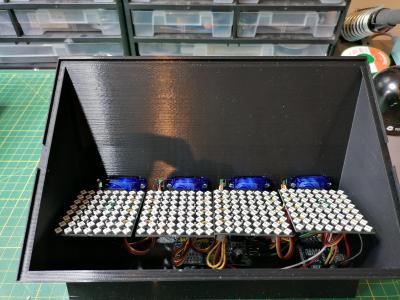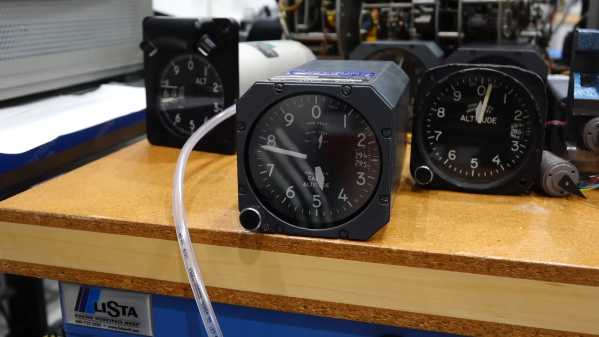If you’ve never heard of Aerial Imaging by Retro-Reflection, or AIRR for short, you’re probably not the only one. It’s a technique developed by researchers at Utsunomiya University that uses beam splitters and retroreflective foil to create the illusion of an image floating freely in the air. Hackaday alum [Moritz v. Sivers] has been experimenting with the technique to make — what else — a clock, appropriately called the Floating Display Clock.
The most commonly available retroreflective films are typically used for things like street signs and high-visibility clothing, but also work perfectly fine for homebrew AIRR setups. [Moritz] tried several types and found that one called Oralite Superlens 3000 resulted in the best image quality. He combined it with a sheet of teleprompter glass and mounted both in their appropriate orientation in a black 3D printed enclosure.
 The projected image is generated by a set of 8×8 RGB LED displays, which are driven by a PCA9685 sixteen-channel servo driver board. A Wemos D1 Mini fetches the time from an NTP server and operates the display system, which includes not only the LED panels but also a set of servos that tilt each digit when it changes, giving the clock an added 3D effect that matches nicely with the odd illusion of digits floating in space.
The projected image is generated by a set of 8×8 RGB LED displays, which are driven by a PCA9685 sixteen-channel servo driver board. A Wemos D1 Mini fetches the time from an NTP server and operates the display system, which includes not only the LED panels but also a set of servos that tilt each digit when it changes, giving the clock an added 3D effect that matches nicely with the odd illusion of digits floating in space.
We can imagine it’s pretty hard to capture the end result on video, and the demonstration embedded below probably doesn’t do it justice. But thanks to [Moritz]’s clear step-by-step instructions on his Instructables page, it shouldn’t be too hard to replicate his project and see for yourself what it looks like in real life.
Although this isn’t a hologram, it does look similar to the many display types that are commonly called “holographic”. If you want to make actual holograms, that’s entirely possible, too.
Continue reading “Clever Optics Make Clock’s Digits Float In Space”













